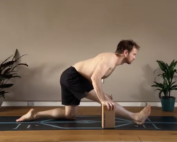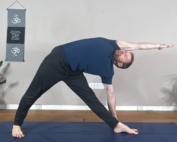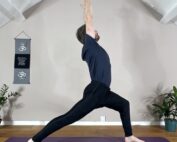
The Power of Dolphin Pose: Steps, Benefits, and Variations
Welcome! I’m Dav Jones, an experienced yoga practitioner and teacher trainer. Today, we’re diving into Dolphin Pose. This blog will explore how to perform this powerful posture, its incredible benefits, and various exciting variations. Let’s get started on enhancing your yoga practice.
What is Dolphin Pose?
Dolphin Pose, or Ardha Pincha Mayurasana, is a yoga posture that combines strength, stability, and flexibility. It’s a pose that involves placing your forearms on the mat while lifting your hips towards the ceiling, forming an inverted V-shape with your body. This posture helps strengthen the shoulders, arms, and core while providing a deep stretch for the posterior legs. The Dolphin Pose is often a preparatory pose for advanced inversions like the Forearm Stand (Pincha Mayurasana).
Dolphin Pose (Ardha Pincha Mayurasana)
- Sanskrit: Ardha Pincha Mayurasana
- Pronunciation: ard-ha pin-cha ma-yur-a-sa-na
- Meaning of Ardha Pincha Mayurasana: “Ardha” means half, “Pincha” means feather, and “Mayura” means peacock, reflecting the half-feathered shape of the peacock’s tail.
Preparatory Poses of Dolphin Pose
Before you try Dolphin Pose, it’s good to warm up with some preparatory poses. These poses help prepare your body by warming up the necessary muscle tissue and mobilising the necessary joints.
Cat-Cow Pose (Marjaryasana-Bitilasana) – Warms up the spine and helps you get comfortable with the movement, preparing the back and neck.


Puppy Dog Pose (Uttana Shishosana) – This is an excellent posture to help stretch and mobilise the thoracic spine and shoulder joints.

Downward-Facing Dog (Adho Mukha Svanasana) – Activates the shoulders, stretches the hamstrings, and strengthens the core, creating a solid foundation for Dolphin Pose.

Downward-Facing Dog Split – Slightly more challenging than Downward Facing Dog, this pose requires more strength through the arms and the legs to execute with poise.

Step-by-Step Guide to Entering Dolphin Pose
This guide provides straightforward steps to enter Dolphin Pose, focusing on guidelines, how to create stability through the body’s joint systems and what muscles to contract and which ones to stretch. It’s designed to help practitioners of all levels safely achieve the benefits of Ardha Pincha Mayurasana, guiding you toward mastering this asana.

Step 1. Starting Position
Come into All-Fours position on the hands and knees.
Step 2. Transition to Dolphin Pose
- Lower your forearms to the mat, ensuring your elbows are roughly shoulder-width apart.
- Place your palms flat on the mat or interlace your fingers.
- As you raise your hips toward the sky and tuck your toes under, raise your hips and press your chest back through the arms towards your legs.
Step 3. Maintaining Dolphin Pose
- Hug your arms towards each other isometrically.
- Option to slightly bend your knees if the pose is overly intense for the posterior leg muscles.
- Hold the pose for 5-10 breaths, focusing on deep, even breathing.
Step 4. Tips for Stability and Mastery
- Aim to create space between the shoulder blades in the upper-back. With the shoulder blades protracted in an upwardly rotated position.
- Direct your inhale breath into the lower side ribs of your body and allow a slow exhale in order to depress the rib-cage, keeping the floating ribs drawn in and the abdominals toned.
Following these steps, you can safely practise Dolphin Pose, building strength, and endurance with regular practice. Flexibility of the posterior leg muscles/connective tissue is often achieved through regular practice.
Dolphin Pose Variations
Dolphin Pose (Ardha Pincha Mayurasana) is a versatile asana that can be adapted to suit various skill levels and objectives in yoga practice. Here, we explore 5 Dolphin Pose variations, each designed to enhance strength, flexibility, and mastery, making the pose accessible and beneficial for practitioners of all experience levels.
Variation 1: Dolphin Pose with Block

Level: All Levels
Using a block between your forearms provides extra support and stability for the arms and shoulder joints.
Steps:
- Place a yoga block between the forearms in Dolphin Pose.
- Press firmly into the block(s), lifting your hips high.
- Hold for 5 breaths, then take rest in Hero’s or Child’s Pose.
Benefits:
- Provides support and stability for shoulders and arms
- Allows for more awareness through the positioning of the ribcage.
Variation 2: One-Legged Dolphin Pose

Level: Intermediate to Advanced
This variation increases the intensity of the stretch and strengthens the shoulders, legs and really works the Glute muscles in the lifted leg.
Steps:
- Start in a dolphin pose with your forearms on the mat and hips lifted.
- Keep stable through your arms, by hugging your forearms isometrically towards each other, and slowly lift one leg towards the ceiling, keeping the standing leg with a slight bend or straightening out if you have the flexibility.
- Hold the position for a few breaths, then switch legs.
Benefits:
- Provides a stronger stretch for the standing leg.
- Builds strength and greater control, and helps prepare for the transition into Pincha Mayurasana (Forearm Stand).
- Strengthens the Gluteus Maximus considerably in the lifted leg.
Avoid If:
- You have shoulder injuries, especially rotator cuff issues.
- Experiencing severe hamstring tightness
Variation 3: Dolphin Pose – Single-Arm Variation.

Level: Intermediate
Whilst in Dolphin Pose and you have sufficient control over the posture, place the hand of one arm on your lower back and hold the posture.
Steps:
- Begin in Dolphin Pose.
- Shift your weight more into the left arm, slowly, take the right hand/arm back and place on your lower back.
- Remaining strong through the grounded arm, aim to hold for 4-5 breaths.
- Make sure to do both arms.
Benefits:
- Considerably strengthens the grounded arm, especially the Serratus Anterior shoulder muscle.
- Improves stability and endurance
- Enhances overall body strength
Variation 4: Dolphin Pose – Single-Arm / Single-Leg Variation.

Level: Intermediate to Advanced
Whilst in Dolphin Pose, shift the dominance of weight into the left arm, place the right hand on your lower back. Keeping stable through the grounded left arm, slowly raise your left leg upwards.
Steps:
- Start in Dolphin Pose.
- Shift the dominance of weight into the left arm, place the right hand on your lower back.
- Keeping stable through the grounded left arm, slowly raise your left leg upwards, balancing with one arm and one foot in this Dolphin variation.
- Hold for 4-5 breaths, then switch sides.
Benefits:
- Improves and challenges balance and coordination.
- Enhances core and shoulder stability
Variation 5: Dolphin Pose – Single-Arm / Single-Leg Bound.

Level: Advanced
Very similar to Variation 4, this time see if you can grab the free foot with the free hand.
Steps:
- Begin in Dolphin Pose.
- Shift the dominance of weight into the left arm, place the right hand on your lower back.
- Keeping stable through the grounded left arm, slowly raise your left leg upwards, balancing with one arm and one foot in this Dolphin variation.
- Bend the knee of the lifted leg, try to reach and grab the foot with the right hand.
- Kick the foot back into the hand to express deeper into the pose.
- Hold for 4-5 breaths, then switch sides.
Benefits:
- Builds upper body strength
- Increases shoulder and arm mobility
- Enhances coordination and control
These Dolphin Pose variations allow practitioners to tailor their practice to their skill level and goals, enhancing the benefits and accessibility of this foundational yoga pose.
Benefits of Dolphin Pose in Yoga
- Strengthens Upper Body: Targets shoulders, arms, and upper back, building muscle strength and endurance.
- Improves Core Stability: Engages the core, strengthening abdominal muscles and supporting the spine.
- Enhances Flexibility: Stretches hamstrings, calves, and Achilles tendons, and anterior chest muscles increasing flexibility.
- Reduces stress and anxiety: Encourages deep, mindful breathing, calming the mind, and reducing stress.
- Prepares for Inversions: Builds strength and familiarity for advanced poses like the forearm stand and headstand.
- Supports Shoulder Mobility: Improves shoulder joint flexibility and mobility for range of motion.
- Boosts Circulation: Enhances blood flow, delivering more oxygen and nutrients to cells.
Tips For Beginners
Follow the suggested proprietary warm-up poses suggested above.
Place your elbows shoulder-width apart and either interlace your fingers or place your palms flat on the mat for stability. Engage your core by drawing your belly button towards your spine, and practice against a wall for additional support. Remember to breathe deeply and listen to your body, avoiding any strain and taking breaks as needed.
Safety and Precautions for Dolphin Pose
- Avoid Strain: Do not push yourself too hard; ease into the pose gradually.
- Shoulder Stability: Keep your elbows roughly shoulder-width apart and hug your forearms towards each to maintain shoulder joint stability.
- Core Engagement: Allow a steady breath and controlled exhale. This in turn will help to the necessary pressures in the abdominal cavity to help with efficient contraction and relaxation of the abdominal muscles.
- Neck Safety: Keep your neck relaxed and try to avoid gritting your teeth.
- Use Modifications: If needed, use props like blocks or practice against a wall for additional support.
- Injury Awareness: Avoid the pose if you have shoulder, neck, or back injuries, or consult a healthcare professional first.
Final Thought
Want to improve your Dolphin Pose and strengthen your lower back? Join Dav Jones Yoga on Patreon for classes tailored to all skill levels. With personalised guidance through the DJY mentorship program, you’ll refine your techniques and enjoy the full benefits of yoga. Whether you’re just starting or looking to advance your yoga practice, these resources will support your growth. Transform your practice with Dav Jones Yoga.









